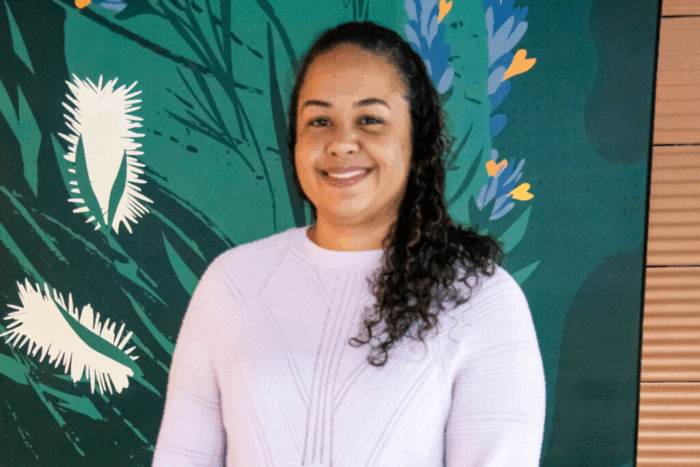One day, Dr. Abiola Keller, associate professor in the College of Nursing, got a message from two of her colleagues saying there was a pattern in their research that merited further study.
Dr. Marianne Weiss, professor emerita in the College of Nursing, teamed up with health economist and former Marquette faculty member Dr. Olga Yakusheva from the University of Michigan to conduct an intervention study with more than 100,000 patients about whether regular assessment of readiness for hospital discharge had any impact on hospital readmission rates.
While the interventions had a positive effect, the two investigators discovered something else: Black patients were receiving referrals for post-hospitalization home health care services less often than their white counterparts, even when patients for the two groups were assessed as similarly prepared to leave the hospital.
“Hospitals are for acute care; there are many treatments that you could not get at home if you were very sick,” Keller says. “However, after that happens, there comes this gray area or even a new normal where they can be home but they need support. Home care allows us to deliver these health care solutions in an environment where people are most comfortable.”
Home health care runs the gamut from nursing to speech therapy to occupational therapy and beyond. When nurses assess how ready a patient is for discharge, they make a recommendation to the health care team about whether a patient would benefit from home health services after discharge. If this intervention is not performed when necessary, the patient has a higher chance of being readmitted to the hospital.
Keller’s paper — co-authored by Weiss, Yakusheva and her University of Michigan colleague Dr. Kathryn Lee — found that Black patients were referred to home health services at a rate of 22 percent, well below the 27-percent rate for white patients. Black patients with the lowest readiness for discharge scores were even less likely to receive a home health care referral at the time of hospital discharge. There were no significant discrepancies found between any other combination of racial or ethnic groups. The group published the paper in Medical Care, an American Public Health Association journal, in December 2023.
“When patients are not given the proper means to address health issues at home, there are tons of negative outcomes from that: readmission to the hospital, increased burden on family caregivers, even early death in extreme cases,” Keller says.
Weiss emphasizes that the study did not investigate why the disparity exists. She also said that while racial bias was one potential explanation for the discrepancy, there are many other viable explanations.
“It may be that there’s bias in clinical assessments; it could be that Black patients aren’t as interested in having a home health visit; there might be a deficit of trust that has to be overcome; there could be any number of reasons why this is happening,” Weiss says. “These were all Medicare patients, so the one we might be able to rule out from this study is insurance, but access to home health care agencies even for people with health insurance can be a problem in some communities.”
The question of the disparity’s causes fits squarely in Keller’s research interest: reducing racial and ethnic disparities in health outcomes for adults with chronic illnesses. Her career-long commitment to this issue started when she was a Burke Scholar at Marquette, performing regular community service in underserved areas and seeing firsthand the impacts of social determinants of health, such as poverty and food insecurity.
Keller also teaches the Culture and Health class that forms part of the university’s core curriculum. This sort of research informs more than just the practice of nursing; it also informs what Keller teaches.
“Once our students’ time at Marquette is complete — not just nursing students, but all students — they are part of protecting and promoting health,” Keller says. “Health is a byproduct of economic stability, neighborhood and built environment, and social support as much as care, and that’s what I try to instill in the people that take my class.”
“Seeing the whole patient is the embodiment of Jesuit education and a way clinicians can be in the fight for social justice,” Keller continues.
While Keller investigates the racial disparity part of the question, Weiss focuses on training nurses to be better discharge educators. Weiss developed the Readiness for Hospital Discharge Scale during her time as an active faculty member. That scale has since been translated into more than a dozen languages and is referenced in so many other research works that Weiss is among the top 2% of the world’s most-cited scientists.
The RHDS measures four areas of patient readiness on a 0-10 scale: personal status, knowledge required for ongoing self-care, perceived coping ability and expected support. Addressing racial imbalances in home health care recommendations starts with accurate patient evaluations using this scale or a similar metric with sufficient scientific foundation.
“Good discharge teaching has two major components to it: the accuracy of the content that nurses are providing to patients and how nurses teach their patients,” Weiss says. “We need nurses to be answering questions, we need them to be sensitive to patients’ needs and make them feel confident, among other things.”
A combination of sound discharge training methods and heightened cultural awareness may be enough to narrow the gap that Keller and Weiss identified, given enough time. Until then, Keller is focused on protecting the well-being of people who are experiencing health inequities, and she hopes her students will do the same.
“Students have to move from being observers of the problem to being agents of change. I think empowering our students to make that transition is living our mission to Be The Difference and is hopefully how we can solve some of these problems,” Keller says.



